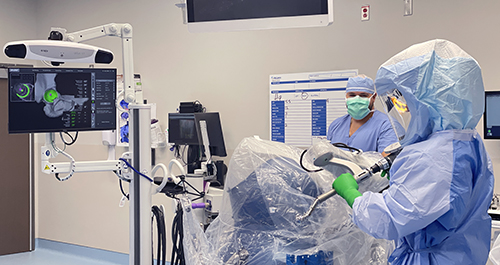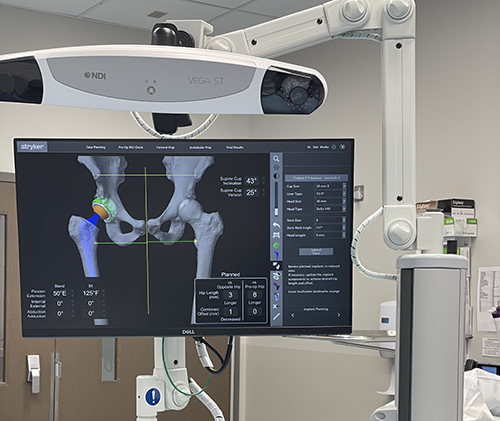The MAKO® robot may benefit you
Author: Sarah Barber

"The benefits of robotic joint replacement for my patients have been numerous. The largest difference I have noticed in my patients is they are walking with confidence right after surgery."
According to the Center of Orthopedic and Neurosurgical Care and Research nearly one million hip and knee replacement surgeries are performed in the United States annually, making it one of the most common orthopedic procedures performed today.
With so many Americans needing or considering a knee or hip joint replacement it’s important to know how those surgeries are performed, and what options are available to you.
“The Mako® robotic arm is a surgeon operated and controlled tool, and is one of the latest technologies available for hip and knee replacement surgeries,” said Daniel Mesko, DO, fellowship trained, orthopedic surgeon who works with McLaren Greater Lansing. “This technology has been around since 2006, and has been used for more than half a million cases. The Mako® robotic arm isn’t required to have a great outcome for your joint replacement surgery, but it can be beneficial for many patients.”
What specifically does the MAKO® robot do? And should I find a surgeon who uses it for my joint replacement surgery?
This technology is unique in that it uses a Computed Tomography (CT) scan that provides the surgeon a 3D model of the joint they are replacing before they make a single cut. This road map allows the surgeon to make a clear plan in sizing and implant positioning before surgery begins.
“If the patient has had previous surgeries such as spinal fusions, previous hardware placement, or has experienced traumatic injuries to the area like fractures, the robot can really help us pre-plan and navigate for those specific cases taking into account the altered anatomy,” said Dr. Mesko.
The MAKO® robot can be used for full or partial knee replacements and hip replacements utilizing any approach including anterior, mini-posterior or lateral based approaches. The company is also looking at expanding this technology for shoulder, pelvis, and spinal surgeries in the future.
What are the benefits of MAKO® robotic-assisted surgery?
“The benefits of robotic joint replacement for my patients have been numerous. The largest difference I have noticed in my patients is they are walking with confidence right after surgery,” said Steven Drayer, MD, orthopedic surgeon and robotic specialist who works with McLaren Greater Lansing. “When they come in for their post-operative appointment, they aren’t using a cane or walker.”
Using the MAKO® robotic arm can also include additional benefits like CT based accuracy of component positioning and patient matched sizing, achieving accuracy in areas such as balancing a knee throughout the entire arc of motion as well as leg length accuracy in total hips.
The potential benefits of lower incidence of hip instability, less need for long term revisions and a diminished risk of something unplanned arising during surgery also may exist. “Although patients experience some pain after surgery, my patients have less anxiety in their recovery and are quicker to ask when they might have their next replacement performed,” said Dr. Drayer.
To learn more about robotic-assisted knee and hip replacement and the surgeons who perform robotic-assisted surgeries at McLaren Greater Lansing, click here.
